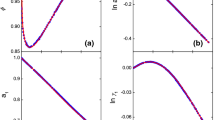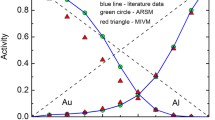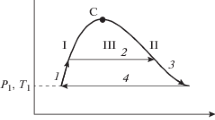Abstract
Derivations are given for the thermodynamic relations that are needed to compare experimental thermodynamic excess functions of various kinds with the corresponding functions obtained from models for the solutions by calculations made in the framework of the McMillan-Mayer theory. This contribution extends earlier results. The new results are used to elucidate the behavior of the McMillan-Mayer thermodynamic excess functions of solutions which are very nearly ideal on the mole-fraction scale, for example, isotope mixtures. The study of these ideal systems leads to the conclusion that liquid-structure effects associated with the packing of molecules contribute a negative term to the potential of the force between solute particles in the solvent.
Similar content being viewed by others
References
W. G. McMillan and J. E. Mayer,J. Chem. Phys. 13, 276 (1945).
J. C. Poirier,J. Chem. Phys. 21, 965 (1953).
H. L. Friedman,J. Chem. Phys. 32, 1351 (1960).
H. L. Friedman,Ionic Solution Theory (Interscience Publishers, New York, 1962).
H. L. Friedman, Computed Thermodynamic Properties and Distribution Functions for Simple Models of Ionic Solutions, inModern Aspect of Electrochemistry, J. O'M. Bockris and B. E. Conway, eds. (Plenum Press, New York, 1971).
G. N. Lewis and M. Randall,Thermodynamics (McGraw-Hill Book Co., New York, 1923).
H. S. Harned and B. B. Owen,The Physical Chemistry of Electrolyte Solutions (Reinhold Publishing Corp., New York, 1958), 3rd ed.
P. S. Ramanathan and H. L. Friedman,J. Chem. Phys. 54, 1086 (1962).
J. C. Rasaiah and H. L. Friedman,J. Chem. Phys. 48, 2742 (1968);J. Chem. Phys. 50, 3965 (1969).
H. L. Friedman and P. S. Ramanathan,J. Phys. Chem. 74, 3756 (1970).
M. Setchenow,Ann. Chim. Phys. 25, 226 (1892).
H. A. C. McKay,Trans. Faraday Soc. 49, 237 (1959).
H. L. Friedman,J. Phys. Chem. 59, 161 (1955).
B. E. Conway, J. E. Desnoyers, and A. C. Smith,Proc. Roy. Soc. A256, 389 (1964).
W. Y. Wen and J. Hung,J. Phys. Chem. 74, 170 (1970).
M. Lucas and A. de Trobriand,J. Phys. Chem. 75, 1803 (1971).
G. R. Haugen and H. L. Friedman,J. Phys. Chem. 60, 1363 (1956).
G. R. Haugen and H. L. Friedman,J. Phys. Chem. 67, 1757 (1963).
G. N. Lewis, M. Randall, K. S. Pitzer, and L. Brewer,Thermodynamics and the Free Energy of Chemical Substances (McGraw-Hill Book Co., New York, 1961), 2nd ed.
H. L. Friedman, C. V. Krishnan, and C. Jolicoeur, Ionic Interactions in Water, Annals of the New York Academy of Sciences, in press.
H. S. Harned and B. B. Owen,The Physical Chemistry of Electrolyte Solutions (Reinhold Publishing Corp., New York, 1958), 3rd ed., Eq. (8-7-22).
E. A. Guggenheim,Thermodynamics (North-Holland Publishing Co., Amsterdam, 1957), 3rd ed.
J. H. Hildebrand and R. L. Scott,The Solubility of Nonelectrolytes (Reinhold Publishing Co., New York, 1950), 3rd ed.
T. L. Hill,J. Chem. Phys. 30, 93 (1959).
D. Stigter,J. Phys. Chem. 64, 118 (1960).
J. J. Kozak, W. S. Knight, and W. Kauzmann,J. Chem. Phys. 48, 675 (1968).
J. G. Kirkwood and F. P. Buff,J. Chem. Phys. 19, 774 (1951).
B. Zimm,J. Chem. Phys. 21, 934 (1953); F. P. Buff and R. Brout,J. Chem. Phys. 23, 458 (1955).
D. G. Hall,Trans. Faraday Soc. 67, 2516 (1971).
D. G. Hall,Trans. Faraday Soc. 68, 25 (1972).
H. L. Friedman,Ionic Solution Theory (Interscience Publishers, New York, 1962), Eq. (18.50).
Author information
Authors and Affiliations
Rights and permissions
About this article
Cite this article
Friedman, H.L. Lewis-Randall to McMillan-Mayer conversion for the thermodynamic excess functions of solutions. Part I. Partial free energy coefficients. J Solution Chem 1, 387–412 (1972). https://doi.org/10.1007/BF00645603
Received:
Revised:
Issue Date:
DOI: https://doi.org/10.1007/BF00645603




